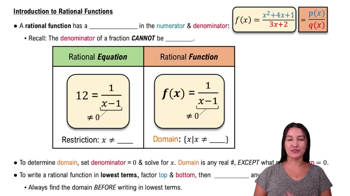Table of contents
- 0. Functions7h 52m
- Introduction to Functions16m
- Piecewise Functions10m
- Properties of Functions9m
- Common Functions1h 8m
- Transformations5m
- Combining Functions27m
- Exponent rules32m
- Exponential Functions28m
- Logarithmic Functions24m
- Properties of Logarithms34m
- Exponential & Logarithmic Equations35m
- Introduction to Trigonometric Functions38m
- Graphs of Trigonometric Functions44m
- Trigonometric Identities47m
- Inverse Trigonometric Functions48m
- 1. Limits and Continuity2h 2m
- 2. Intro to Derivatives1h 33m
- 3. Techniques of Differentiation3h 18m
- 4. Applications of Derivatives2h 38m
- 5. Graphical Applications of Derivatives6h 2m
- 6. Derivatives of Inverse, Exponential, & Logarithmic Functions2h 37m
- 7. Antiderivatives & Indefinite Integrals1h 26m
- 8. Definite Integrals4h 44m
- 9. Graphical Applications of Integrals2h 27m
- 10. Physics Applications of Integrals 2h 22m
1. Limits and Continuity
Finding Limits Algebraically
Problem 2.48c`
Textbook Question
Horizontal and Vertical Asymptotes
Use limits to determine the equations for all horizontal asymptotes.
_____
√x² + 4
c. g(x) = -----------
x
 Verified step by step guidance
Verified step by step guidance1
Step 1: Identify the function g(x) = (√(x² + 4)) / x. We need to find the horizontal asymptotes by evaluating the limits of g(x) as x approaches infinity and negative infinity.
Step 2: Consider the limit as x approaches infinity. Simplify the expression by dividing the numerator and the denominator by x, the highest power of x in the denominator: g(x) = (√(x² + 4) / x) = √(1 + 4/x²).
Step 3: Evaluate the limit as x approaches infinity: lim (x -> ∞) √(1 + 4/x²). As x becomes very large, 4/x² approaches 0, so the expression simplifies to √1 = 1. Therefore, the horizontal asymptote as x approaches infinity is y = 1.
Step 4: Consider the limit as x approaches negative infinity. The expression remains the same: g(x) = √(1 + 4/x²).
Step 5: Evaluate the limit as x approaches negative infinity: lim (x -> -∞) √(1 + 4/x²). Similarly, as x becomes very large in magnitude, 4/x² approaches 0, so the expression simplifies to √1 = 1. Therefore, the horizontal asymptote as x approaches negative infinity is also y = 1.
 Verified video answer for a similar problem:
Verified video answer for a similar problem:This video solution was recommended by our tutors as helpful for the problem above
Video duration:
3mPlay a video:
Was this helpful?
Key Concepts
Here are the essential concepts you must grasp in order to answer the question correctly.
Limits
Limits are fundamental in calculus, representing the value that a function approaches as the input approaches a certain point. They are essential for analyzing the behavior of functions at specific points, particularly at infinity, which is crucial for determining asymptotes.
Recommended video:

One-Sided Limits
Horizontal Asymptotes
Horizontal asymptotes describe the behavior of a function as the input approaches infinity or negative infinity. A function has a horizontal asymptote if the limit of the function approaches a constant value as x approaches infinity, indicating that the function levels off at that value.
Recommended video:

Graphs of Exponential Functions
Rational Functions
Rational functions are ratios of two polynomials. Understanding their structure is vital for finding asymptotes, as the degrees of the numerator and denominator determine the existence and location of horizontal asymptotes, influencing the function's end behavior.
Recommended video:

Intro to Rational Functions

 5:21m
5:21mWatch next
Master Finding Limits by Direct Substitution with a bite sized video explanation from Callie
Start learning